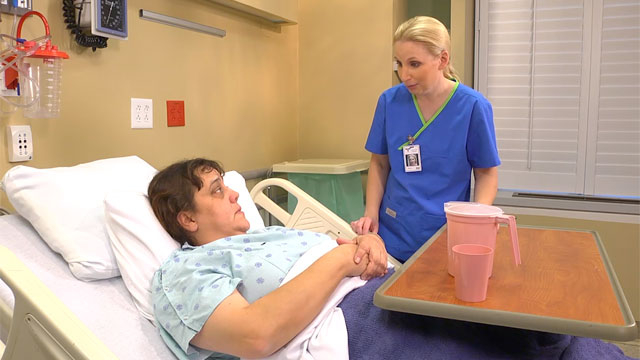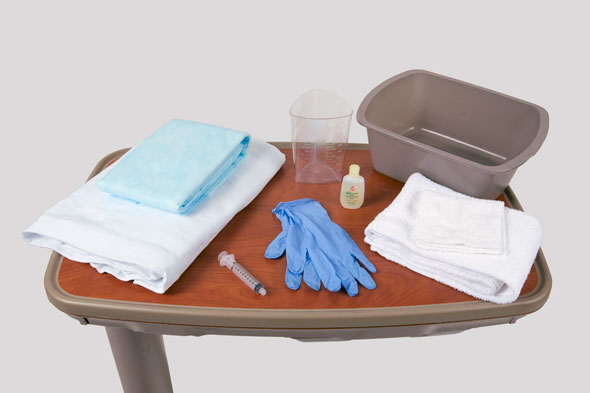Urinary Catheter Management
Select a Skill:
- » Inserting an Indwelling Urinary Catheter in a Female Patient
- » Inserting an Indwelling Urinary Catheter in a Male Patient
- » Irrigating a Urinary Catheter
- » Performing Intermittent Straight Catheterization
- » Obtaining a Specimen from an Indwelling Urinary Catheter
- » Removing an Indwelling Urinary Catheter
- » Caring for a Suprapubic Catheter
Take the Review Test:

Safety
- Limit the use of indwelling urinary catheters to essential conditions, and remove the catheter as soon as medically possible.
- In order to minimize trauma to the urethra, be sure the catheter balloon has been fully deflated when removing an indwelling urinary catheter.
- Use a voiding record or bladder diary to monitor voiding in the first 24 to 48 hours after catheter removal.
- Inform patients of their risk for infection, and provide information about prevention measures they may take. Let patients know what signs they need to report to their primary care provider. Symptoms of infection can develop two or more days after catheter removal.
Equipment
(Roll cursor over items to see labels)

10mL or larger syringe without needle
Waterproof pad
Clean gloves
Bath blanket
Graduated cylinder
Soap
Washcloth and towel
Basin
Delegation
The skill of removing an indwelling urinary catheter can be delegated to NAP; however, the nurse must first assess the patient’s status, verify the provider’s order, and validate that agency policy allows NAP to do so. Be sure to inform NAP of the following:
- Specify characteristics of the urine that NAP should report to you, including color, clarity, odor, and amount.
- Instruct NAP to report the condition of the patient’s genital area, including color, rashes, open areas, odor, soiling from fecal incontinence, and any trauma to the urinary meatus.
- Review how to check the size of the balloon and syringe needed to deflate the balloon; instruct NAP to report if the balloon does not deflate, and to report if there is bleeding after catheter removal.
- Remind NAP to report the time and amount of first voiding after the catheter is removed.
- Instruct NAP to report any patient complaints that might indicate a complication, such as dysuria, hematuria, urgency, frequency, lower abdominal pain, change in mental status, lethargy, fever, chills, burning, flank pain, back pain, or blood in the urine.
Preparation
- Review the patient’s medical record, including the health care provider’s order and documentation. Note how long the catheter has been in place and how much fluid was used to fill the catheter balloon.
- Assess the patient’s knowledge and prior experience with catheter removal.
- Assess the color, clarity, odor, and amount of the patient’s urine.
- Note any urethral discharge, irritation of the genital region, or trauma to the urinary meatus. This assessment may be deferred until just before catheter removal.
Follow-up
- Inspect the catheter and genital area for soiling, irritation, and skin breakdown. Ask the patient if he or she has any discomfort.
- Observe the time of first voiding after catheter removal, and measure the amount. Evaluate the patient for symptoms of a UTI, such as dysuria, hematuria, urgency, frequency, lower abdominal pain, change in mental status, lethargy, fever, chills, burning, flank pain, back pain, or blood in the urine.
Documentation
- Record and report the time of catheter removal, the condition of the urethral meatus and catheter, and the time, amount, and characteristics of the first voided urine.
- Record any teaching related to catheter removal and fluid intake.
- Report any hematuria, dysuria, inability to void or difficulty voiding, and any new incontinence after a catheter has been removed.
Review Questions
1. When preparing to discharge a patient who had an indwelling urinary catheter removed 24 hours ago, the nurse would offer patient education regarding which common complication?
2. Which action would best minimize a patient’s risk for infection during removal of an indwelling urinary catheter?
 The nurse or nursing assistive personnel (NAP) removing the catheter must employ clean technique.
The nurse or nursing assistive personnel (NAP) removing the catheter must employ clean technique.  A registered nurse, not NAP, must remove the catheter.
A registered nurse, not NAP, must remove the catheter. Catheter removal must be executed within 10 minutes of beginning the procedure.
Catheter removal must be executed within 10 minutes of beginning the procedure.  Catheter removal must take place within 5 days of catheter insertion.
Catheter removal must take place within 5 days of catheter insertion.
3. Which statement might the nurse make to nursing assistive personnel (NAP) caring for a patient who has just had an indwelling urinary catheter removed?
 “Teach the patient the signs of a urinary tract infection.”
“Teach the patient the signs of a urinary tract infection.” “Tell me when and how much the patient first voids.”
“Tell me when and how much the patient first voids.” “Explain that voiding might be uncomfortable for 4 to 5 days.”
“Explain that voiding might be uncomfortable for 4 to 5 days.” “Assess the patient for a distended bladder before the end of the shift.”
“Assess the patient for a distended bladder before the end of the shift.”
4. Which nursing action minimizes a patient’s risk for injury during removal of an indwelling urinary catheter?
 Using a 5-mL syringe to deflate the balloon
Using a 5-mL syringe to deflate the balloon Using sterile scissors to cut the valve to deflate the balloon
Using sterile scissors to cut the valve to deflate the balloon Tugging gently on the catheter to pull the balloon through the urethra
Tugging gently on the catheter to pull the balloon through the urethra Checking the documentation for the volume of fluid used to inflate the balloon
Checking the documentation for the volume of fluid used to inflate the balloon
5. Which is not an expected outcome on a first voiding after catheter removal?
You have completed the Review Questions for this skill. To take the Review again select the Start Over button. To proceed to another skill select from the dropdown menu. Select the Home or Back button to proceed to the next section.

